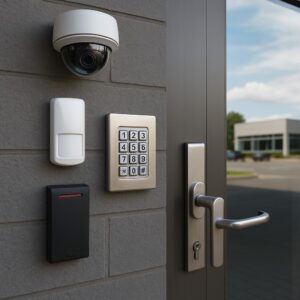Key Takeaways
- Understand the essential components of commercial security systems.
- Learn how modern technologies are enhancing security measures.
- Discover the importance of integrating surveillance, access control, and alarm systems.
- Explore the role of regular maintenance in ensuring optimal performance.

Introduction
In today’s ever-evolving digital landscape, ensuring the security of commercial spaces has become a top priority for business owners worldwide. With threats ranging from theft to more complex cyber intrusions, having a sophisticated security setup is no longer a luxury but a necessity. A thoughtfully designed security system not only protects physical assets but also provides safety for employees and peace of mind for business owners. Those interested in an in-depth understanding of commercial security systems can learn more about the latest innovations and best practices.
Essential Components of Commercial Security Systems
A reliable security system is built on several critical components that work together to safeguard a commercial establishment. At the core of this system are surveillance cameras, access control measures, and alarm systems. Surveillance cameras provide constant monitoring, capturing every possible angle of a facility. Access control systems determine who is granted entry, while alarm systems act as alert mechanisms in cases of breaches or emergencies. When integrated effectively, these components create a seamless security network that can prevent unauthorized access and respond swiftly to potential threats.
Integrating Surveillance Technology
Surveillance cameras are arguably the most visible aspect of a security system. These devices come in a variety of types, including dome cameras that offer a broad field of view, bullet cameras known for their long-range capabilities, and PTZ (pan-tilt-zoom) cameras that can be maneuvered remotely. Modern cameras are equipped with advanced features such as night vision, high-definition recording, and motion detection to enhance their efficacy. Innovations in smart surveillance also allow for real-time alerts that notify security personnel of suspicious behavior, reducing the response time to potential threats.
Role of Access Control
Access control is a critical factor in any security strategy, as it determines who can enter specific areas within a business. Modern systems utilize technologies such as smart cards, biometric scans, and keypad entries to ensure only authorized personnel gain access. These solutions protect sensitive information and secure valuable company resources from internal and external threats. Implementing multi-factor authentication, which requires a combination of two or more identification methods, can significantly enhance security measures by making unauthorized access attempts much more difficult. With continuous advancements in technology, businesses now have the ability to fine-tune access control features to fit their specific security needs.
Alarm Systems and Their Vital Role
Alarm systems play a critical role in commercial security, acting as both deterrents for potential intruders and notification systems for imminent threats. Beyond traditional burglar alarms, businesses can implement advanced alarm systems that detect environmental changes, such as smoke or carbon monoxide, and alert for fire emergencies. Having a comprehensive alarm system ensures that responses to various incidents are swift and coordinated. Real-time notifications, whether sent through a dedicated control room or via mobile alerts, enable immediate action, minimizing potential damage and safeguarding lives and assets.
Maintenance: An Often Overlooked Necessity
For a security system to remain effective, regular maintenance is essential. Yet, maintenance often gets overlooked until a problem arises. Routine checks help identify potential issues before they become critical, ensuring that all components function as intended. This involves inspecting physical equipment for any signs of damage, updating software to protect against vulnerabilities, and running drills to confirm system responsiveness.
The Rise of Integrated Security Solutions
Integrated security systems are increasingly becoming the standard for modern businesses, offering more comprehensive protection by linking multiple security components through a single interface. This integration not only simplifies the monitoring process but also allows for a more holistic approach to security management. By centralizing control, security teams can quickly assess and respond to incidents, ultimately reducing the potential for security lapses. Such systems are especially beneficial in large facilities where coordinating responses to threats can be challenging.
Technological Advancements in Security
The introduction of AI and IoT into the realm of security has significantly transformed the capabilities of security systems. AI-driven analytics provide predictive insights, allowing businesses to anticipate and neutralize threats before they occur. Additionally, IoT devices enable better connectivity between security components, ensuring efficient data transfer and real-time updates. For instance, AI-powered surveillance systems can differentiate between daily activities and suspicious actions, reducing false alarms and enhancing response precision. Businesses that embrace these technologies are setting new standards in proactive security management.
Conclusion
In conclusion, a comprehensive commercial security system is essential for ensuring the safety and security of businesses today. It protects valuable physical and intellectual assets and instills confidence in employees and clients alike. By understanding and investing in advanced security measures and keeping them well-maintained, businesses can effectively protect themselves from the ever-evolving landscape of security threats. Consistent evaluation and updates are vital to maintaining an effective security posture, and businesses must remain vigilant and informed to stay ahead in this crucial aspect of operations.



